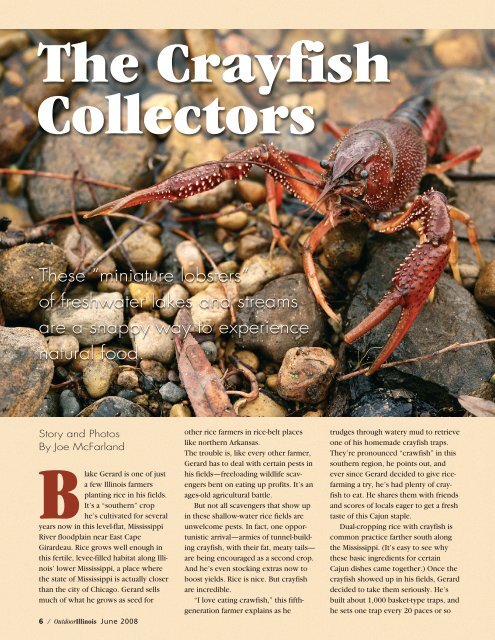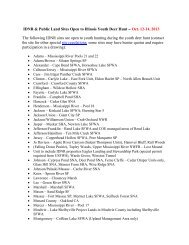The Crayfish Collectors - Illinois DNR
The Crayfish Collectors - Illinois DNR
The Crayfish Collectors - Illinois DNR
Create successful ePaper yourself
Turn your PDF publications into a flip-book with our unique Google optimized e-Paper software.
<strong>The</strong> <strong>Crayfish</strong><br />
<strong>Collectors</strong><br />
<strong>The</strong>se “miniature lobsters”<br />
of freshwater lakes and streams<br />
are a snappy way to experience<br />
natural food.<br />
Story and Photos<br />
By Joe McFarland<br />
Blake Gerard is one of just<br />
a few <strong>Illinois</strong> farmers<br />
planting rice in his fields.<br />
It’s a “southern” crop<br />
he’s cultivated for several<br />
years now in this level-flat, Mississippi<br />
River floodplain near East Cape<br />
Girardeau. Rice grows well enough in<br />
this fertile, levee-filled habitat along <strong>Illinois</strong>’<br />
lower Mississippi, a place where<br />
the state of Mississippi is actually closer<br />
than the city of Chicago. Gerard sells<br />
much of what he grows as seed for<br />
6 / Outdoor<strong>Illinois</strong> June 2008<br />
other rice farmers in rice-belt places<br />
like northern Arkansas.<br />
<strong>The</strong> trouble is, like every other farmer,<br />
Gerard has to deal with certain pests in<br />
his fields—freeloading wildlife scavengers<br />
bent on eating up profits. It’s an<br />
ages-old agricultural battle.<br />
But not all scavengers that show up<br />
in these shallow-water rice fields are<br />
unwelcome pests. In fact, one opportunistic<br />
arrival—armies of tunnel-building<br />
crayfish, with their fat, meaty tails—<br />
are being encouraged as a second crop.<br />
And he’s even stocking extras now to<br />
boost yields. Rice is nice. But crayfish<br />
are incredible.<br />
“I love eating crawfish,” this fifthgeneration<br />
farmer explains as he<br />
trudges through watery mud to retrieve<br />
one of his homemade crayfish traps.<br />
<strong>The</strong>y’re pronounced “crawfish” in this<br />
southern region, he points out, and<br />
ever since Gerard decided to give ricefarming<br />
a try, he’s had plenty of crayfish<br />
to eat. He shares them with friends<br />
and scores of locals eager to get a fresh<br />
taste of this Cajun staple.<br />
Dual-cropping rice with crayfish is<br />
common practice farther south along<br />
the Mississippi. (It’s easy to see why<br />
these basic ingredients for certain<br />
Cajun dishes came together.) Once the<br />
crayfish showed up in his fields, Gerard<br />
decided to take them seriously. He’s<br />
built about 1,000 basket-type traps, and<br />
he sets one trap every 20 paces or so
(Photo By Adele Hodde.)<br />
Armed with fierce pincers for<br />
defense and for grabbing prey,<br />
the ubiquitous crayfish—pronounced<br />
and spelled crawfish<br />
in some regions—is often overlooked<br />
as a tasty meal. Catching<br />
enough crayfish to eat is a<br />
fun way to spend a summer<br />
afternoon. <strong>The</strong>re is no limit.<br />
But an <strong>Illinois</strong> sportfishing<br />
license is required for anyone<br />
16 and older, unless exempt.<br />
among the dozens of acres of rice fields<br />
beginning in late May. He even encourages<br />
higher yields by stocking adult<br />
crayfish in his rice fields each July and<br />
harvests offspring the following May.<br />
He points out rice farmers south of<br />
here have been doing this dual-cropping<br />
trick for ages, so Gerard didn’t<br />
invent the technique. In fact, the crayfish<br />
industry is so well-established,<br />
there are trade products available that<br />
folks elsewhere might not realize exist.<br />
“I bait my traps with crawfish bait,”<br />
Gerard says matter-of-factly. “Yes, there<br />
is such a thing.”<br />
Of course, this rice farmer isn’t<br />
alone in his appreciation for these<br />
miniature lobsters. Elsewhere, others in<br />
(Photo By Adele Hodde.)<br />
aquaculture-related fields are taking full<br />
advantage of the windfall bonanza that<br />
appears when rearing ponds are<br />
drained. A little farther north, at Logan<br />
Hollow Fish Farm in Murphysboro,<br />
employees scramble to fill 5-gallon<br />
buckets with tasty crayfish during certain<br />
fish harvests—it’s a perk of<br />
employment.<br />
“It’s kind of hit or miss,” explains<br />
Logan Hollow owner Pete Reiff, who<br />
A Cajun staple: Restaurants in<br />
America’s Gulf region serve spicy,<br />
boiled “crawfish” as commonly as<br />
deep-dish pizza is served in Chicago.<br />
said some ponds produce loads of crayfish<br />
during spring harvests while others<br />
do not. Although he doesn’t sell the<br />
crayfish to the public, the crayfish “harvest”<br />
can be huge, and Logan Hollow<br />
employees always keep an eye open for<br />
these private culinary benefits.<br />
“In the years you really want to get a<br />
bunch, you don’t find many,” Reiff<br />
added. “But in years when you’re not<br />
trying to find crayfish you’re tripping<br />
over them.”<br />
For back-to-nature chefs interested<br />
in acquiring Prairie State crayfish for a<br />
meal, the source of these shrimp-like<br />
tails can be as close as a backyard pond<br />
or creek.<br />
June 2008 Outdoor<strong>Illinois</strong> / 7
Know that not all crayfish are created<br />
equal, says James Fetzner, an <strong>Illinois</strong><br />
native and crayfish specialist who<br />
earned his doctorate studying these<br />
pincher-wielding crustaceans. <strong>The</strong> familiar<br />
“volcanoes” of mud that appear in<br />
damp soils—sometimes in front yards—<br />
are created by species of crayfish that<br />
are scarcely worth collecting for food.<br />
“<strong>The</strong> ones people see building those<br />
mud towers out in fields tend to have<br />
pretty small tails,” Fetzner explained.<br />
“If you want to collect crayfish to eat,<br />
you’re better off collecting in shallow,<br />
rocky streams. And bring a net. While I<br />
was doing my research (at Southern <strong>Illinois</strong><br />
University), I had my best success<br />
making collections in rocky streams.”<br />
Another method of crayfish-catching<br />
is one especially favored by kids since<br />
all that is required is a chunk of bait<br />
(such as a fish carcass), a few feet of<br />
string and a bit of patience. <strong>The</strong> ravenous<br />
and greedy crayfish hiding among<br />
rocks along shorelines will grab the bait<br />
and cling tenaciously to it, even as the<br />
string and bait are lifted gently from the<br />
water. Most crayfish won’t let go of the<br />
bait until they’ve been lifted well out of<br />
the water—and over a bucket.<br />
<strong>Illinois</strong> crayfish farmer Blake<br />
Gerard hauls in one of his baited<br />
traps at the end of the 2007<br />
season. Gerard began raising these<br />
edible crustaceans as an alternate<br />
“crop” in his Mississippi River<br />
floodplain rice fields.<br />
<strong>Crayfish</strong> recipes from Cajun etouffee<br />
to boiled-in-the-shell crayfish abound<br />
online. Most chefs recommend storing<br />
the crayfish alive in cold water for a<br />
couple of days to allow them to purge<br />
themselves. It makes for a cleaner-tasting<br />
crayfish.<br />
All that one needs to legally collect<br />
crayfish in <strong>Illinois</strong> is a sportfishing<br />
license for anyone 16 or older, and to<br />
observe local site regulations.<br />
Although crayfish are not included on<br />
advisory lists for sportfish consumption<br />
in <strong>Illinois</strong>, crayfish do have the<br />
ability to accumulate mercury, PCBs<br />
and other known toxins in contaminated<br />
bodies of water. A simple and<br />
appropriate approach when deciding<br />
whether or not to eat crayfish from<br />
any body of water is to review the<br />
health advisories for <strong>Illinois</strong> lakes and<br />
rivers (listed in the 2008 <strong>Illinois</strong> Fishing<br />
Information guide or online at<br />
www.dnr.state.il.us/fish/digest. Health<br />
officials suggest that avoiding crayfish<br />
from bodies of water where sportfish<br />
are known to contain high levels of<br />
any toxin would be a safe, commonsense<br />
approach to good eating.<br />
So many locals begged for a fresh<br />
supply of “crawfish,” Gerard<br />
expanded his farming operation.<br />
8 / Outdoor<strong>Illinois</strong> June 2008

















